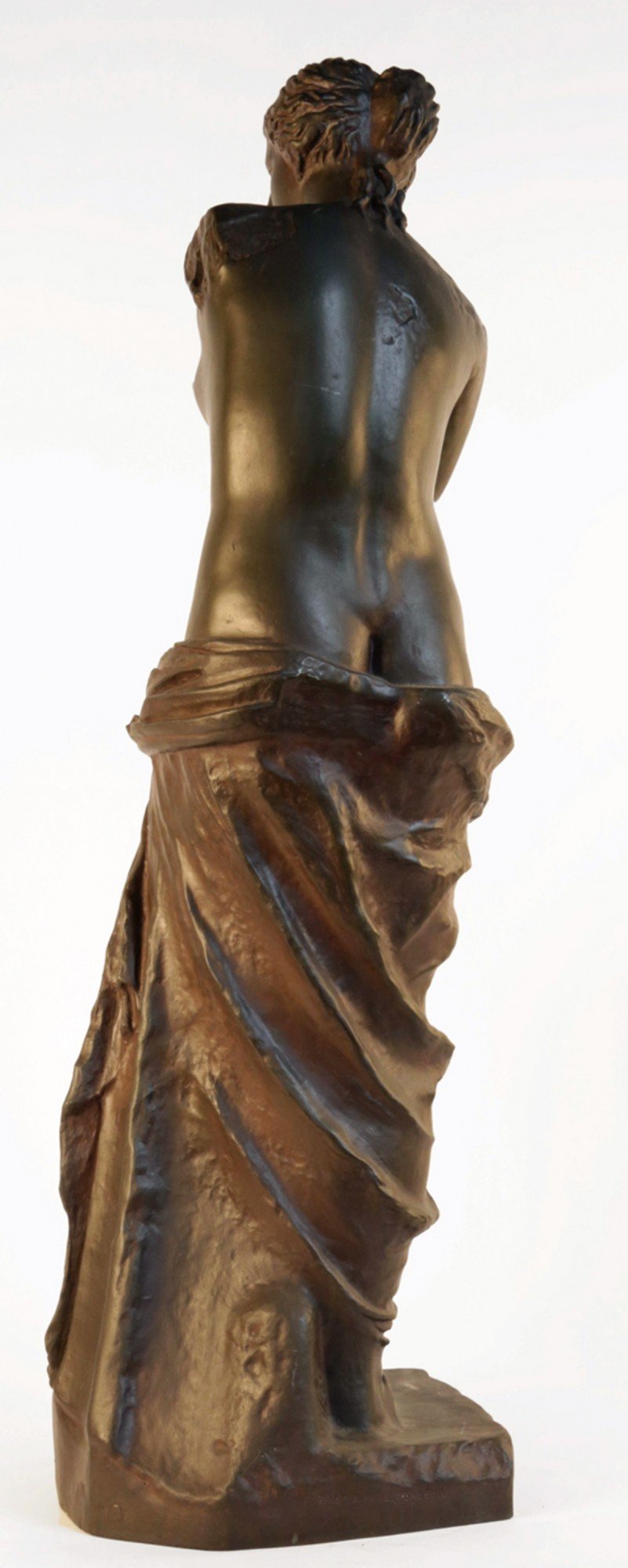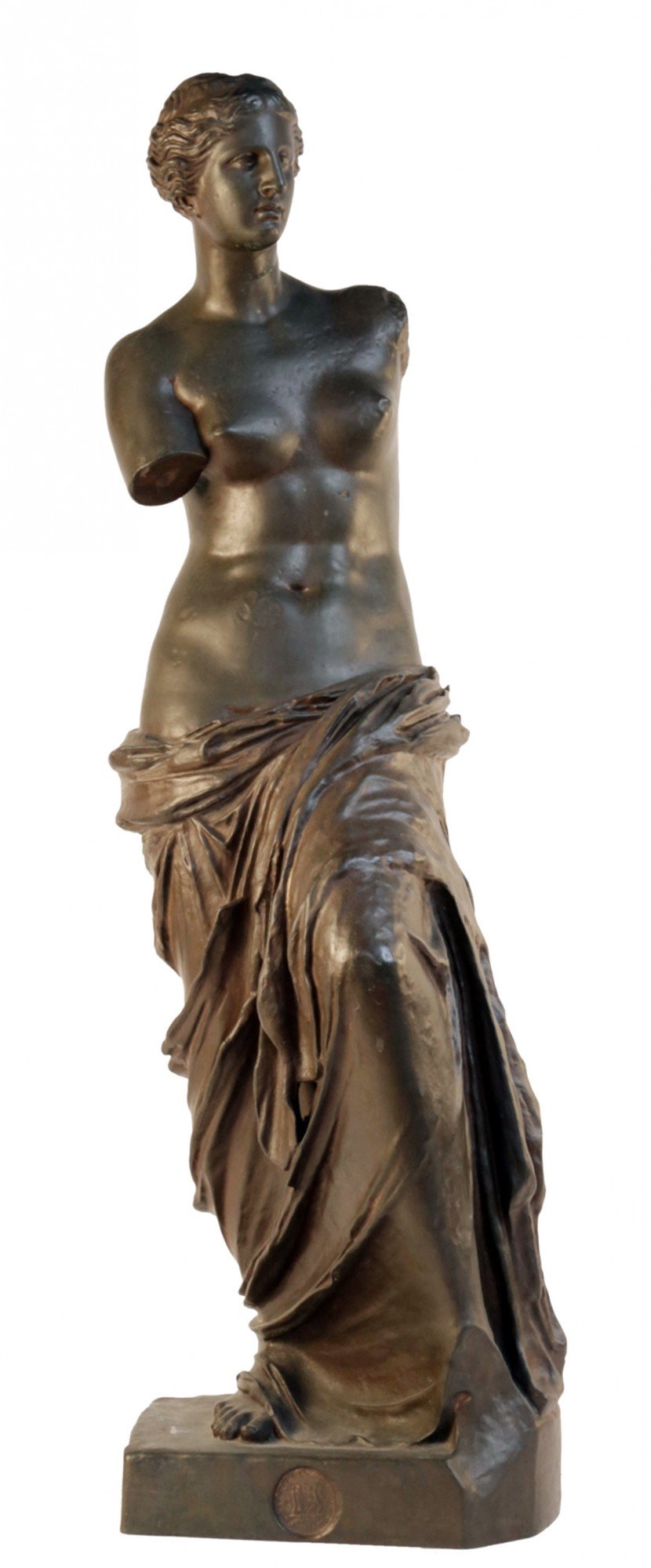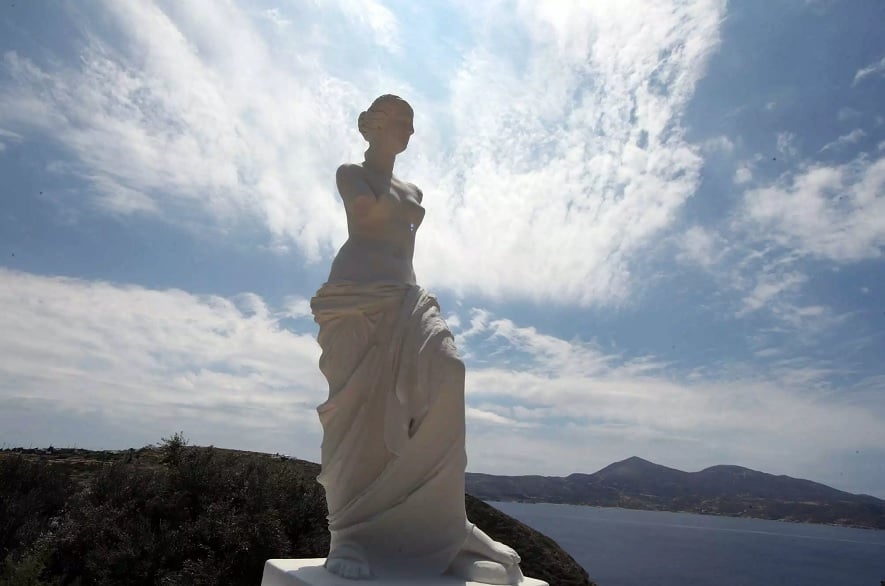
Aphrodite of Melos Venus De Milo statue sculpture 14.2inch Etsy
The statue Aphrodite as a souvenir. She is available as a small marble statue in many shops on Milos. Aphrodite of Milos symbolises the ideal of feminine beauty. The marble from which it is made comes from the island of Paros, although it is still not known which sculptor produced it.

Venus de Milo
The statue of the goddess was found on the Aegean island of Milos, to which she owes her name, on the eve of the Greek War of Independence (1821-1830 CE). With her delicate face and elegant curves, she is a vision of grace and beauty. She gazes serenely ahead, her expression peaceful, befitting a goddess.

Vénus de Milo (Aphrodite de Milos), l'une des plus célèbres sculptures
Aphrodite of Melos (Venus de Milo) Semi-nude female figure. The pose is based on the much earlier Aphrodite of Capua. Clearly her left arm was raised and her right crossed her body, but more than that is unclear. Like the Parthenon Marbles, it was not restored after discovery, but the two halves it consists of were badly joined, and re-set in 1870.

Venus de Milo or the Aphrodite de Milos Collection WOLFS Fine
Advertisement Search Results Definition by Mark Cartwright Aphrodite Aphrodite was the ancient Greek goddess of love, beauty, desire, and all aspects of sexuality. She could entice both gods and men into illicit affairs with her beauty and whispered sweet nothings. Aphrodite was born near Cyprus from the severed. Article by Branko van Oppen
Aphrodite of Melos (Venus de Milo) Museum of Classical Archaeology
The Aphrodite of Milos, often called Venus de Milo or just the Venus statue, is one example of such amazing works created during the Hellenistic period (i.e. the Graeco-Egyptian period). Created sometime between 150 and 125 BC, the Venus de Milo is universally recognized as one of the greatest works of art ever created.

Venus de Milo or the Aphrodite de Milos Inventory WOLFS Fine
Aphrodite— the goddess of love for ancient Greeks —had been depicted by artists of that time as a woman of exceptional beauty. The Venus de Milo statue, which is one of the most beautiful interpretations of the goddess, is believed to be the work of ancient sculptor Alexandros of Antioch.

Venus de Milo. The Louvre Museum. Paris, France. On the LONDON & PARIS
3D reconstruction of Aphrodite of Milo, better known as the Venus de Milo. Created sometime between 130 and 100 BC, the statue is believed to depict Aphrodite, the Greek goddess of love and beauty (Venus to the Romans). From an inscription that was on its plinth, it is thought to be the work of Alexandros of Antioch.

Stunning Aphrodite of Milos Statue Unveiled on the Greek Island
It all started in 1820 when a farmer by the name of Yorgos Kentrotas (though there is no consensus on the farmer's exact name) discovered the Venus de Milo statue quite by accident, somewhere between the village of Tripiti and the ancient Christian Catacombs.

Venus de Milo AKA Aphrodite of Milos (if you're into that whole Greek
Make way for the goddess! The Venus de Milo entered the Louvre in 1821 but her location within the museum has been changed several times. Unsurprisingly, she was first placed in the Galerie des Antiques, where she can still be admired today. But a number of questions arose: should she be displayed alone or among other artworks?
Aphrodite of Milos or Venus de Milo? Archaeology Travel
Detailed Reviews and Recent Photos. Know What To Expect Before You Book.

Découvrez les 5 petites merveilles de Milos en Grèce Mitsou Magazine
History Venus of Milos Venus of Milos The famous statue of Venus of Milos (Aphrodite of Milos): One of the most famous ancient Greek statues was discovered on the Greek island of Milos at the beginning of the 19th century. This statue is called Venus (Aphrodite) of Milos. Aphrodite was the Greek goddess of love and beauty.

Greek civilization, 2nd century b.C. Marble statue of Aphrodite of
Known also as the Aphrodite of Milos, the Venus de Milo is a marble sculpture that was likely created by Alexandros of Antioch (2nd - 1st century BCE)-a Greek sculptor from the Hellenistic period —during the late 2nd century BCE. It features a nearly nude, larger-than-life (6 feet, 8 inches tall) female figure posed in a classical S-curve.

Aphrodite of Milos (Greek Ἀφροδίτη τῆς Μήλου, Aphroditē tēs Mēlou
Venus (Aphrodite) is the goddess of love. She was depicted in the nude or in various stages of nudity (and painted). The figure is executed in the Hellenistic style and famed for its sensuous appearance.. To compensate for their loss the French promoted the Venus de Milo as the loveliest of all antique statues of woman. An Englishman even.

Head of Aphrodite from Milos ars mundi
One of the most famous examples of ancient Greek sculpture, the Venus de Milo is immediately recognizable by its missing arms and popularly believed to represent Aphrodite, the Greek goddess of.

Aphrodite dite Vénus de Milo Images d’Art
The Venus de Milo is believed to depict Aphrodite, the Greek goddess of love, whose Roman counterpart was Venus. Made of Parian marble, the statue is larger than life size, standing over 2 metres (6 ft 7 in) high. The statue is missing both arms.

Stunning Aphrodite of Milos Statue Unveiled on the Greek Island
sculpture External Websites Written by Leonard R. Rogers Sculptor and writer. Former Head, Faculty of Three-Dimensional Design, College of Art and Design, Loughborough, England. Author of Sculpture: Appreciation of the Arts; Relief Sculpture.